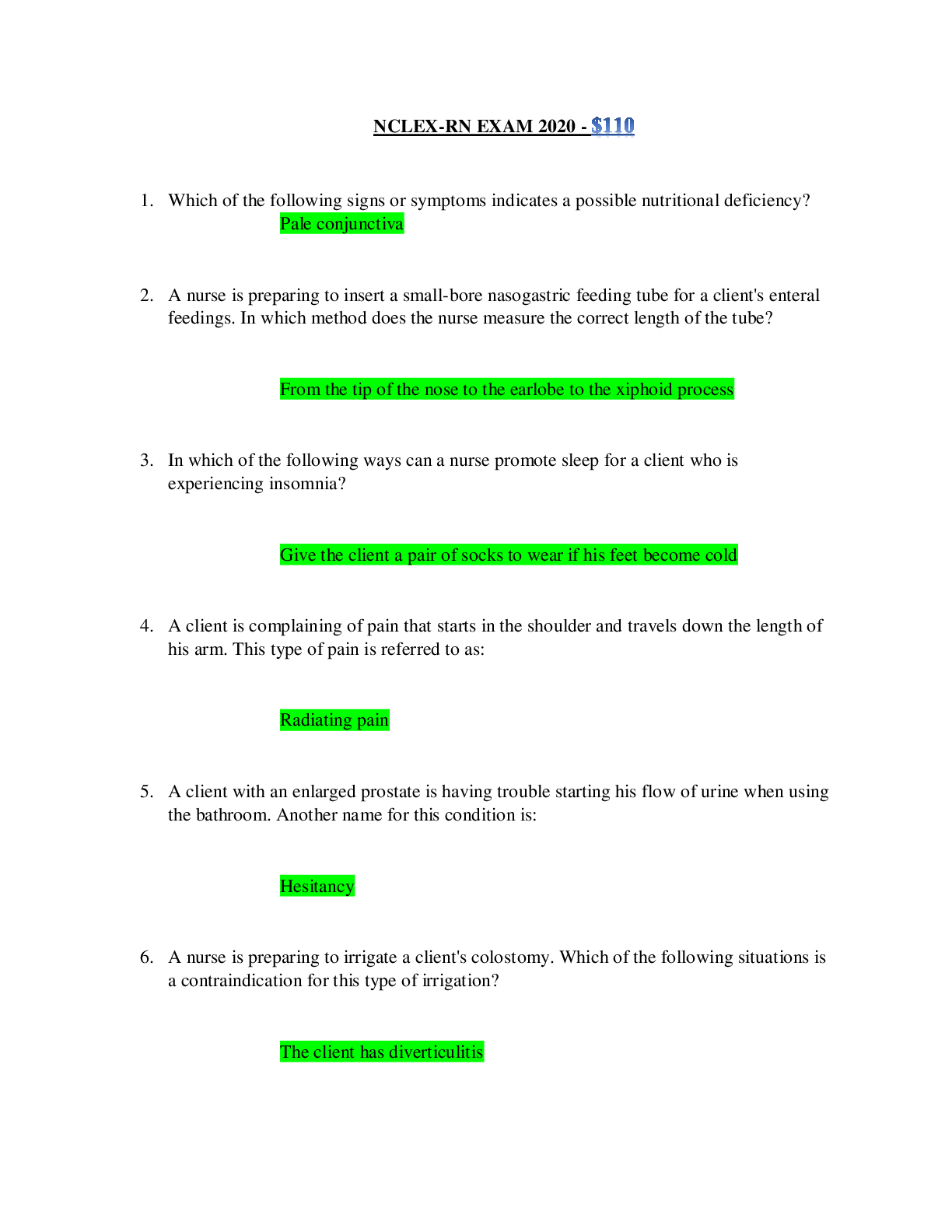*NURSING > NCLEX-RN > C H A P T E R 1 3 Provision of a Safe Environment: From Saunders Comprehensive Review for the NCLEX- (All)
C H A P T E R 1 3 Provision of a Safe Environment: From Saunders Comprehensive Review for the NCLEX-RN Examination 8th Edition. (Available: https://bit.ly/2HeJuMt ). Contains Practice questions and Answers with the Rationale, Test-Taking Strategy, Level of Cognitive Ability, Client Needs, Integrated Process, Content Area, Health Problem, Priority Concepts and Reference
Document Content and Description Below
Priority Concepts Infection, Safety I. Environmental Safety A. Fire safety (see Priority Nursing Actions) 1. Keep open spaces free of clutter. 2. Clearly mark fire exits. 3. Know the locations o... f all fire alarms, exits, and extinguishers (Table 13-1; also see Priority Nursing Actions). Priority Nursing Actions Event of a Fire Race 1. Rescue clients who are in immediate danger. 2. Activate the fire alarm. 3. Confine the fire. 4. Extinguish the fire. Pass 5. Obtain the fire extinguisher. 6. Pull the pin on the fire extinguisher. 7. Aim at the base of the fire. 8. Squeeze the extinguisher handle. 9. Sweep the extinguisher from side to side to coat the area of the fire evenly. Reference Potter et al. (2017), pp. 392-393. 4. Know the telephone number for reporting fires. 5. Know the fire drill and evacuation plan of the agency. 6. Never use the elevator in the event of a fire. 7. Turn off oxygen and appliances in the vicinity of the fire. 8. In the event of a fire, if a client is on life support, 414maintain respiratory status manually with an Ambu bag (resuscitation bag) until the client is moved away from the threat of the fire and can be placed back on life support. 9. In the event of a fire, ambulatory clients can be directed to walk by themselves to a safe area and, in some cases, may be able to assist in moving clients in wheelchairs. 10. Bedridden clients generally are moved from the scene of a fire by stretcher, their bed, or wheelchair. 11. If a client must be carried from the area of a fire, appropriate transfer techniques need to be used. 12. If fire department personnel are at the scene of the fire, they will help evacuate clients. Remember the mnemonic RACE (Rescue clients, Activate the fire alarm, Confine the fire, Extinguish the fire) to set priorities in the event of a fire and the mnemonic PASS (Pull the pin, Aim at the base of the fire, Squeeze the handle, Sweep from side to side) to use a fire extinguisher. B. Electrical safety Any electrical equipment that the client brings into the health care facility must be inspected for safety before use. 1. Electrical equipment must be maintained in good working order and should be grounded; otherwise, it presents a physical hazard; remove equipment that is not in proper working order and notify appropriate staff. 2. Use a 3-pronged electrical cord. 3. In a 3-pronged electrical cord, the third, longer prong of the cord is the ground; the other 2 prongs carry the power to the piece of electrical equipment. 4. Check electrical cords and outlets for exposed, frayed, or damaged wires. 5. Avoid overloading any circuit. 6. Read warning labels on all equipment; never operate unfamiliar equipment. 7. Use safety extension cords only when absolutely necessary, and tape them to the floor with electrical tape. 8. Never run electrical wiring under carpets. 9. Never pull a plug by using the cord; always grasp the plug itself. 41510. Never use electrical appliances near sinks, bathtubs, or other water sources. 11. Always disconnect a plug from the outlet before cleaning equipment or appliances. 12. If a client receives an electrical shock, turn off the electricity before touching the client. C. Radiation safety (Refer to Chapter 44 for additional radiation safety measures) 1. Know the protocols and guidelines of the health care agency. 2. Label potentially radioactive material. 3. To reduce exposure to radiation, do the following. a. Limit the time spent near the source. b. Make the distance from the source as great as possible. c. Use a shielding device such as a lead apron. 4. Monitor radiation exposure with a film (dosimeter) badge. 5. Place the client who has a radiation implant in a private room. 6. Never touch dislodged radiation implants. 7. Keep all linens in the client’s room until the implant is removed. D. Disposal of infectious wastes 1. Handle all infectious materials as a hazard. 2. Dispose of waste in designated areas only, using proper containers for disposal. 3. Ensure that infectious material is labeled properly. 4. Dispose of all sharps immediately after use in closed, puncture-resistant disposal containers that are leakproof and labeled or color-coded. Needles (sharps) should not be recapped, bent, or broken because of the risk of accidental injury (needle stick). E. Physiological changes in the older client that increase the risk of accidents (Box 13-1) F. Risk for falls assessment 1. Should be client-centered and include the use of a fall 416risk scale per agency procedures 2. Include the client's own perceptions of their risk factors for falls and their method to adapt to these factors. Areas of concern may include gait stability, muscle strength and coordination, balance, and vision. 3. Assess for any previous accidents. 4. Assess with the client any concerns about their immediate environment, including stairs, use of throw rugs, grab bars, a raised toilet seat, or environmental lighting. 5. Review/analyze the medications, both prescription and nonprescription, that the client is taking that could have side/adverse effects that could place the client at risk for a fall. 6. Determine any scheduled procedures that pose risks to the client. G. Measures to prevent falls (Box 13-2) H. Measures to promote safety in ambulation for the client 1. Gait belt may be used to keep the center of gravity midline. a. Place the belt on the client prior to ambulation. b. Encircle the client’s waist with the belt. c. Hold on to the side or back of the belt so that the client does not lean to one side. d. Return the client to bed or a nearby chair if the client develops dizziness or becomes unsteady. e. When finished safely ambulating the client, remove belt and replace it in its appropriate storage area. I. The Joint Commission: National Patient Safety Goals 2018 1. See Box 13-3 for a list of the National Patient Safety Goals 2. Refer to the following website for detailed information on these goals https://www.jointcommission.org/assets/1/6/NPSG_Chapter_HAP_J J. Steps to prevent injury to the health care worker (Box 13-4) K. Restraints (safety devices) 1. Restraints (safety devices) are protective devices used to limit the physical activity of a client or to immobilize a client or an extremity. a. The agency policy should be checked 417and followed when using side rails. b. The use of side rails is not considered a restraint when they are used to prevent a sedated client from falling out of bed. c. The client must be able to exit the bed easily in case of an emergency when using side rails. Only the top two side rails should be used. d. The bed must be kept in the lowest position. 2. Physical restraints restrict client movement through the application of a device. 3. Chemical restraints are medications given to inhibit a specific behavior or movement. 4. Interventions a. Use alternative devices, such as pressure-sensitive beds or chair pads with alarms or other types of bed or chair alarms, whenever possible. b. If restraints are necessary, the primary health care provider’s (PHCP’s) prescriptions should state the type of restraint, identify specific client behaviors for which restraints are to be used, and identify a limited time frame for use. c. The PHCP’s prescriptions for restraints should be renewed within a specific time frame according to agency policy. d. Restraints are not to be prescribed PRN (as needed). e. The reason for the safety device should be given to the client and the family, and their permission should be sought and documented. f. Restraints should not interfere with any treatments or affect the client’s health problem. g. Use a half-bow, a safety knot (quick release tie), or a restraint with a quick release buckle to secure the device to the bed frame or chair, not to a movable part of bed (including the side rails). h. Ensure that there is enough slack on the straps to allow some movement of the body part. 418i. Assess skin integrity and neurovascular and circulatory status every 30 minutes and remove the safety device at least every 2 hours to permit muscle exercise and to promote circulation (follow agency policies). j. Continually assess and document the need for safety devices (Box 13-5). k. Offer fluids if clinically indicated at least every 2 hours. l. Offer bedpan or toileting every 2 hours. An PHCP’s prescription for use of a safety device (restraint) is needed. Alternative measures for safety devices should always be used first. 5. Alternatives to safety devices for a client with confusion a. Orient the client and family to the surroundings with every interaction and identify the client by their name. b. Explain all procedures and treatments to the client and family. c. Encourage family and friends to stay with the client, and use sitters for clients who need supervision. d. Assign confused and disoriented clients to rooms near the nurses’ station. e. Provide appropriate visual and auditory stimuli, such as a night light, clocks, calendars, television, and a radio, to the client; leave the client’s room door open. f. Place familiar items, such as family pictures, near the client’s bedside. g. Maintain toileting routines. h. Eliminate bothersome treatments, such as nasogastric tube feedings, as soon as possible. i. Evaluate all medications that the client is receiving. j. Use relaxation techniques with the client. k. Institute exercise and ambulation schedules as the client’s condition allows. l. Collaborate with the PHCP to evaluate oxygenation status, vital signs, 419electrolyte/laboratory values, and other pertinent assessment findings that may provide information about the cause of the client’s confusion. L. Poisons 1. A poison is any substance that impairs health or destroys life when ingested, inhaled, or otherwise absorbed by the body. 2. Specific antidotes or treatments are available only for some types of poisons. 3. The capacity of body tissue to recover from a poison determines the reversibility of the effect. 4. Poison can impair the respiratory, circulatory, central nervous, hepatic, gastrointestinal, and renal systems of the body. 5. The infant, toddler, the preschooler, and the young school-age child must be protected from accidental poisoning. 6. In older adults, diminished eyesight and impaired memory may result in accidental ingestion of poisonous substances or an overdose of prescribed medications. 7. A Poison Control Center phone number should be visible on the telephone in homes with small children; in all cases of suspected poisoning, the number should be called immediately. 8. Interventions a. Remove any obvious materials from the mouth, eyes, or body area immediately. b. Identify the type and amount of substance ingested. c. Call the Poison Control Center before attempting an intervention. d. If the victim vomits or vomiting is induced, save the vomitus if requested to do so, and deliver it to the Poison Control Center. e. If instructed by the Poison Control Center to take the person to the emergency department, call an ambulance. f. Never induce vomiting following 420ingestion of lye, household cleaners, grease, or petroleum products. g. Never induce vomiting in an unconscious victim. The Poison Control Center should be called first before attempting an intervention. II. Health Care–Associated (Nosocomial) Infections A. Health care–associated (nosocomial) infections also are referred to as hospital-acquired infections. B. These infections are acquired in a hospital or other health care facility and were not present or incubating at the time of a client’s admission. C. Clostridium difficile is spread mainly by hand-to-hand contact in a health care setting. Clients taking multiple antibiotics for a prolonged period are most at risk. D. Common drug-resistant infections: Vancomycin-resistant enterococci (VRE), methicillin-resistant Staphylococcus aureus (MRSA), multidrug-resistant tuberculosis, carbapenem-resistant Enterobacteriaceae (CRE) E. Illness and some medications such as immunosuppressants impair the normal defense mechanisms. F. The hospital environment provides exposure to a variety of virulent organisms that the client has not been exposed to in the past; therefore, the client has not developed resistance to these organisms. G. Infections can be transmitted by health care personnel who fail to practice proper standard precautions (i.e., hand-washing procedures or failing to change gloves between client contacts). H. At many health care agencies, dispensers containing an alcoholbased solution for hand sanitization are mounted at the entrance to each client’s room; it is important to note that alcohol-based sanitizers are not effective against some infectious agents such as Clostridium difficile spores; therefore, handwashing is necessary. III. Standard Precautions A. Description 1. Nurses must practice standard precautions with all clients in any setting, regardless of the diagnosis or presumed infectiveness. 2. Standard precautions include hand washing and the use of gloves, as well as washing hands after gloves are removed. Additionally, standard precautions include the use of masks, eye protection, and gowns, when appropriate, for client contact. 3. These precautions apply to blood, all body fluids 421 Practice Questions 100. The nurse is preparing to initiate an intravenous (IV) line containing a high dose of potassium chloride using an IV infusion pump. While preparing to plug the pump cord into the wall, the nurse finds that no receptacle is available in the wall socket. The nurse should take which action? 1. Initiate the IV line without the use of a pump. 2. Contact the electrical maintenance department for assistance. 3. Plug in the pump cord in the available plug above the room sink. 4. Use an extension cord from the nurses’ lounge for the pump plug. 101. The nurse obtains a prescription from a primary health care provider to restrain a client and instructs an assistive personnel (AP) to apply the safety device to the client. Which observation of unsafe application of the safety device would indicate that further instruction is required for the AP? 1. Placing a safety knot in the safety device straps 2. Safely securing the safety device straps to the side rails 3. Applying safety device straps that do not tighten when force is applied against them 4. Securing so that 2 fingers can slide easily between the safety device and the client’s skin 102. The community health nurse is providing a teaching session about anthrax to 434members of the community and asks the participants about the methods of transmission. Which answers by the participants would indicate that teaching was effective? Select all that apply. 1. Bites from ticks or deer flies 2. Inhalation of bacterial spores 3. Through a cut or abrasion in the skin 4. Direct contact with an infected individual 5. Sexual contact with an infected individual 6. Ingestion of contaminated undercooked meat 103. The nurse is giving report to an assistive personnel (AP) who will be caring for a client in hand restraints (safety devices). How frequently should the nurse instruct the AP to check the tightness of the restrained hands? 1. Every 2 hours 2. Every 3 hours 3. Every 4 hours 4. Every 30 minutes 104. The nurse is reviewing a plan of care for a client with an internal radiation implant. Which intervention, if noted in the plan, indicates the need for revision of the plan? 1. Wearing gloves when emptying the client’s bedpan 2. Keeping all linens in the room until the implant is removed 3. Wearing a lead apron when providing direct care to the client 4. Placing the client in a semiprivate room at the end of the hallway 105. Contact precautions are initiated for a client with a health care–associated (nosocomial) infection caused by methicillin-resistant Staphylococcus aureus (MRSA). The nurse prepares to provide colostomy care and should obtain which protective items to perform this procedure? 1. Gloves and gown 2. Gloves and goggles 3. Gloves, gown, and shoe protectors 4. Gloves, gown, goggles, and a mask or face shield 106. The nurse enters a client’s room and finds that the wastebasket is on fire. The nurse immediately assists the client out of the room. What is the next nursing action? 1. Call for help. 2. Extinguish the fire. 3. Activate the fire alarm. 4. Confine the fire by closing the room door. 107. A mother calls a neighbor who is a nurse and tells the nurse that her 3-yearold child has just ingested liquid furniture polish. The nurse would direct the mother to take which immediate action? 1. Induce vomiting. 2. Call an ambulance. 3. Call the Poison Control Center. 4354. Bring the child to the emergency department. 108. The emergency department (ED) nurse receives a telephone call and is informed that a tornado has hit a local residential area and that numerous casualties have occurred. The victims will be brought to the ED. The nurse should take which initial action? 1. Prepare the triage rooms. 2. Activate the emergency response plan specific to the facility. 3. Obtain additional supplies from the central supply department. 4. Obtain additional nursing staff to assist in treating the casualties. 109. The nurse is caring for a client with meningitis and implements which transmission-based precaution for this client? 1. Private room or cohort client 2. Personal respiratory protection device 3. Private room with negative airflow pressure 4. Mask worn by staff when the client needs to leave the room 110. The nurse working in the emergency department (ED) is assessing a client who recently returned from Nigeria and presented complaining of a fever at home, fatigue, muscle pain, and abdominal pain. Which action should the nurse take next? 1. Check the client’s temperature. 2. Isolate the client in a private room. 3. Check a complete set of vital signs. 4. Contact the primary health care provider. [Show More]
Last updated: 1 year ago
Preview 1 out of 28 pages
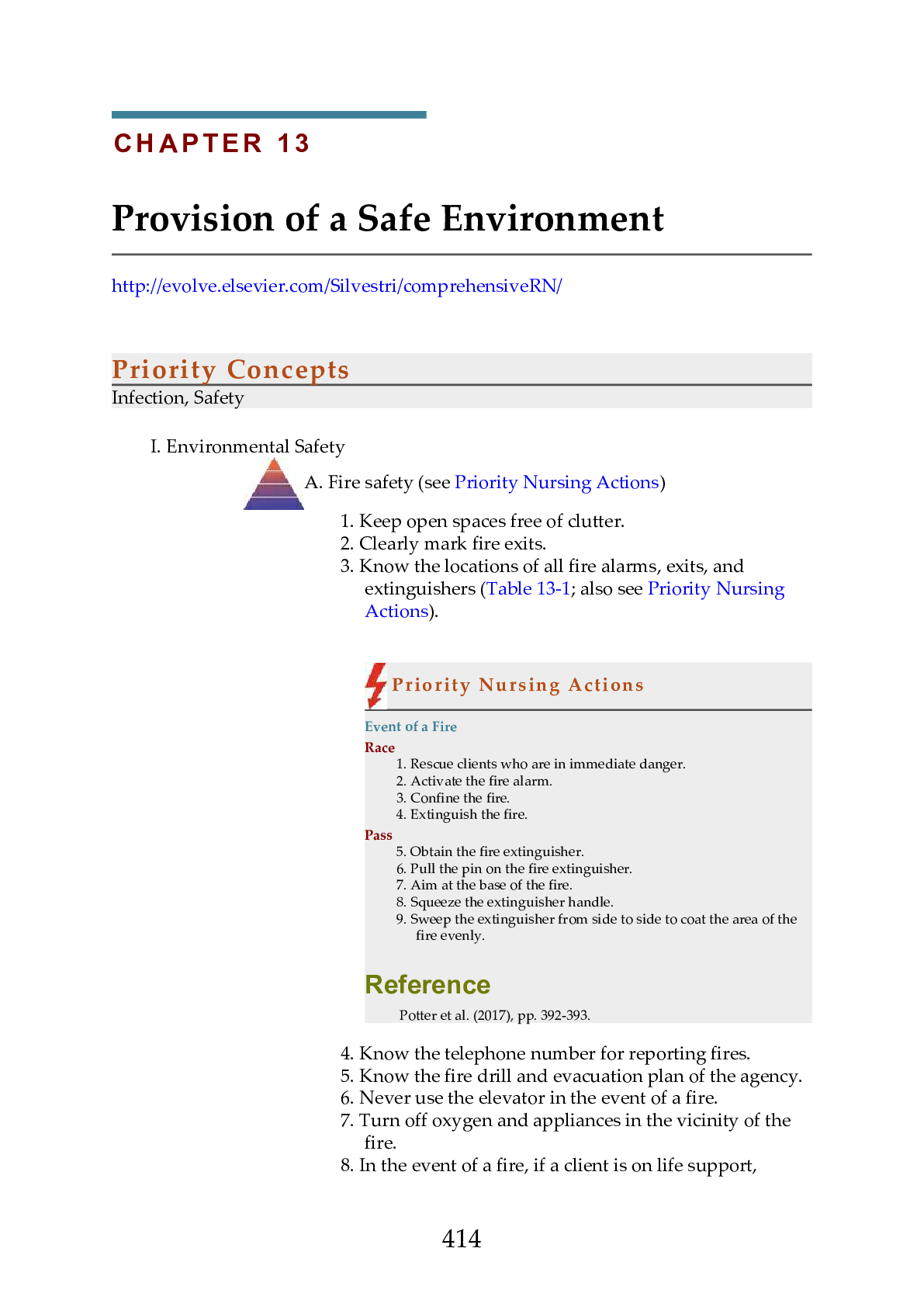
Reviews( 0 )
Document information
Connected school, study & course
About the document
Uploaded On
Oct 22, 2020
Number of pages
28
Written in
Additional information
This document has been written for:
Uploaded
Oct 22, 2020
Downloads
0
Views
96


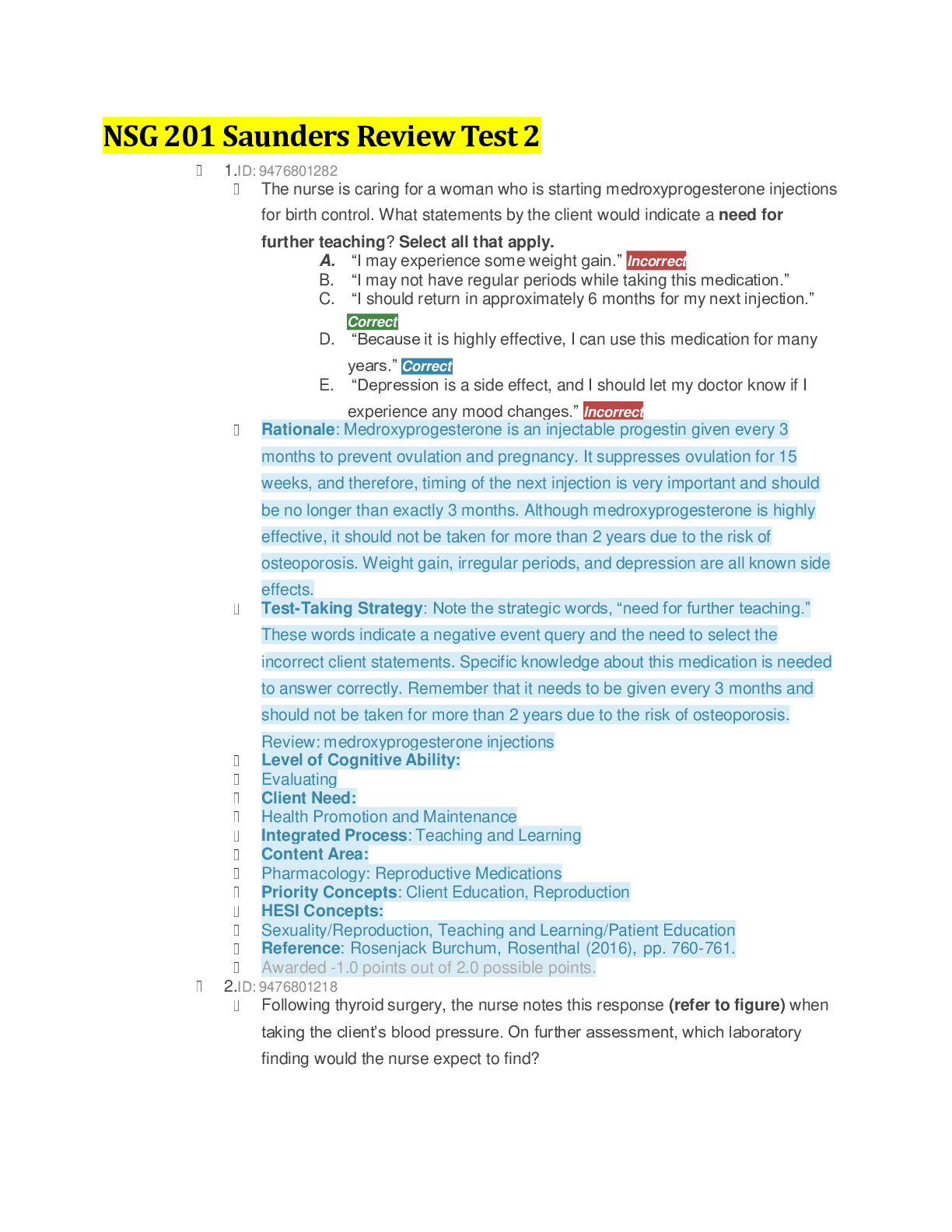

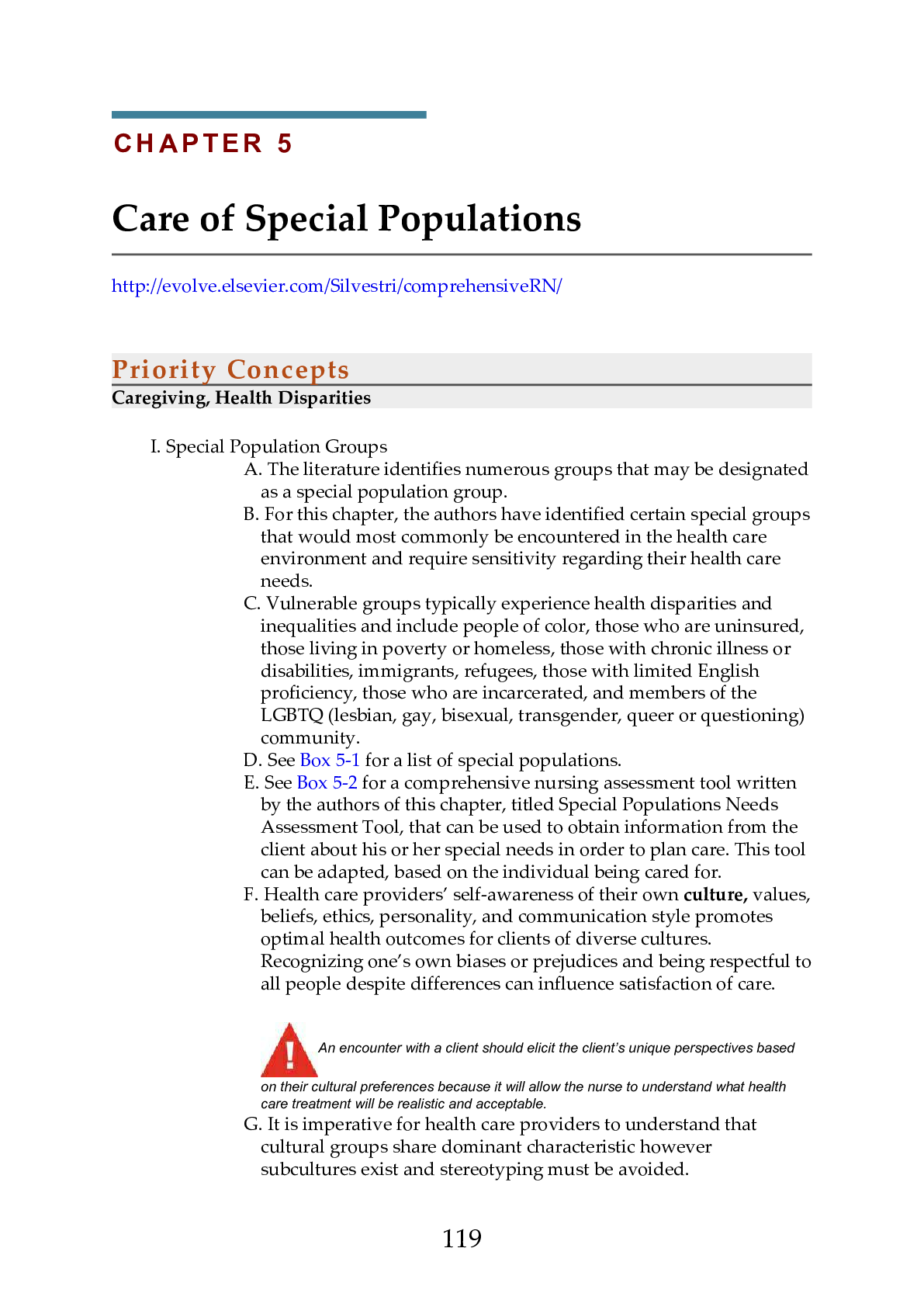

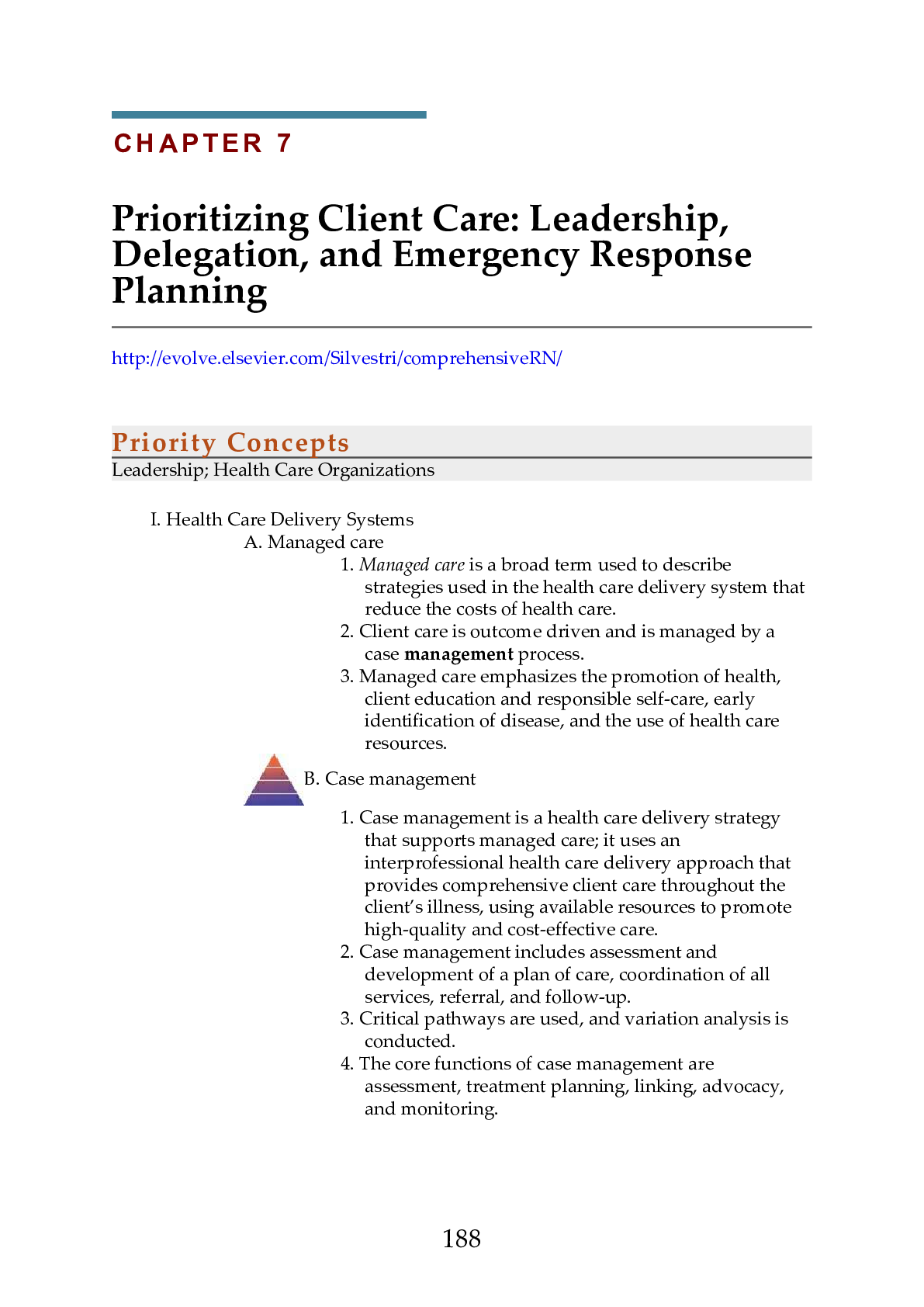

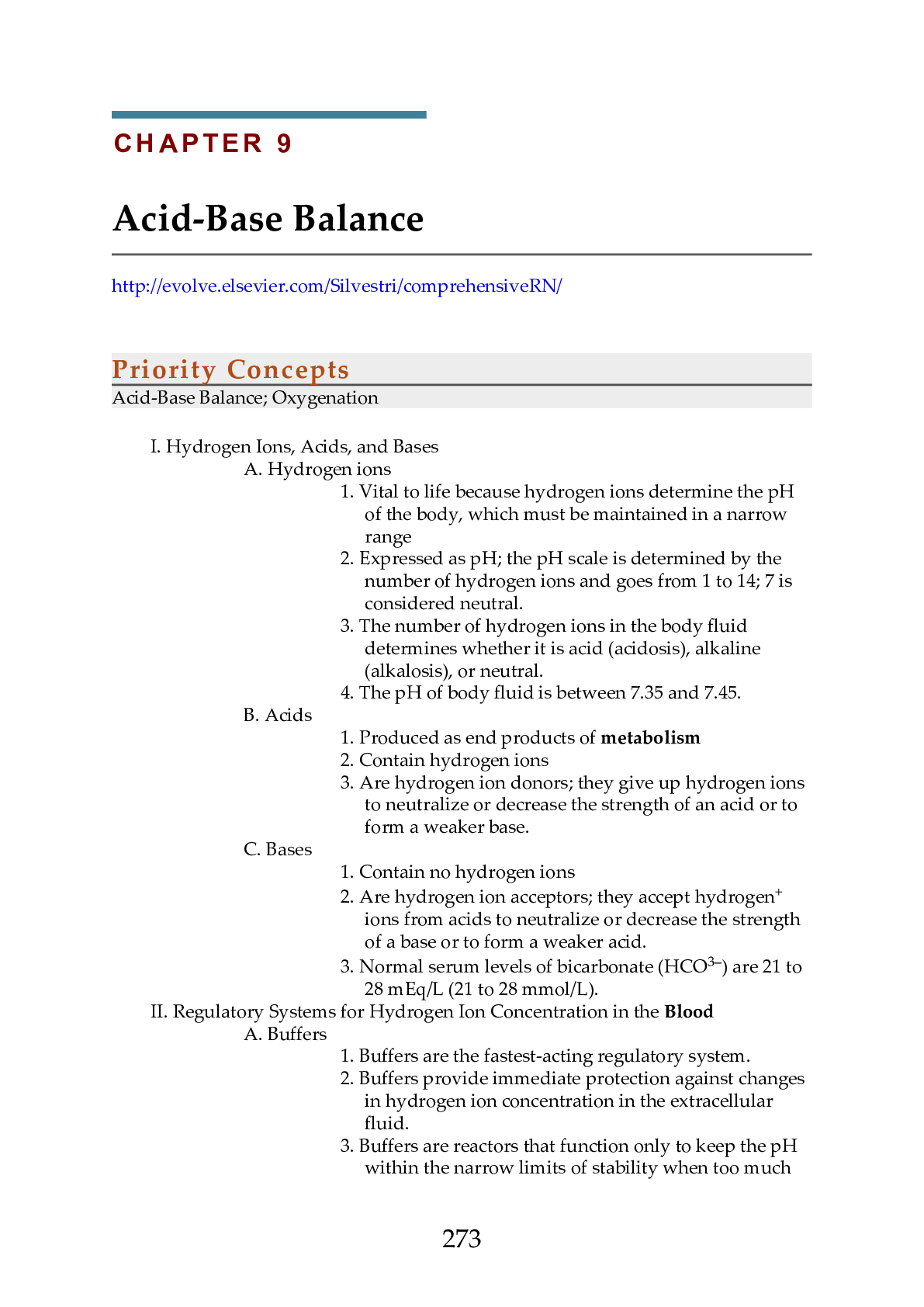





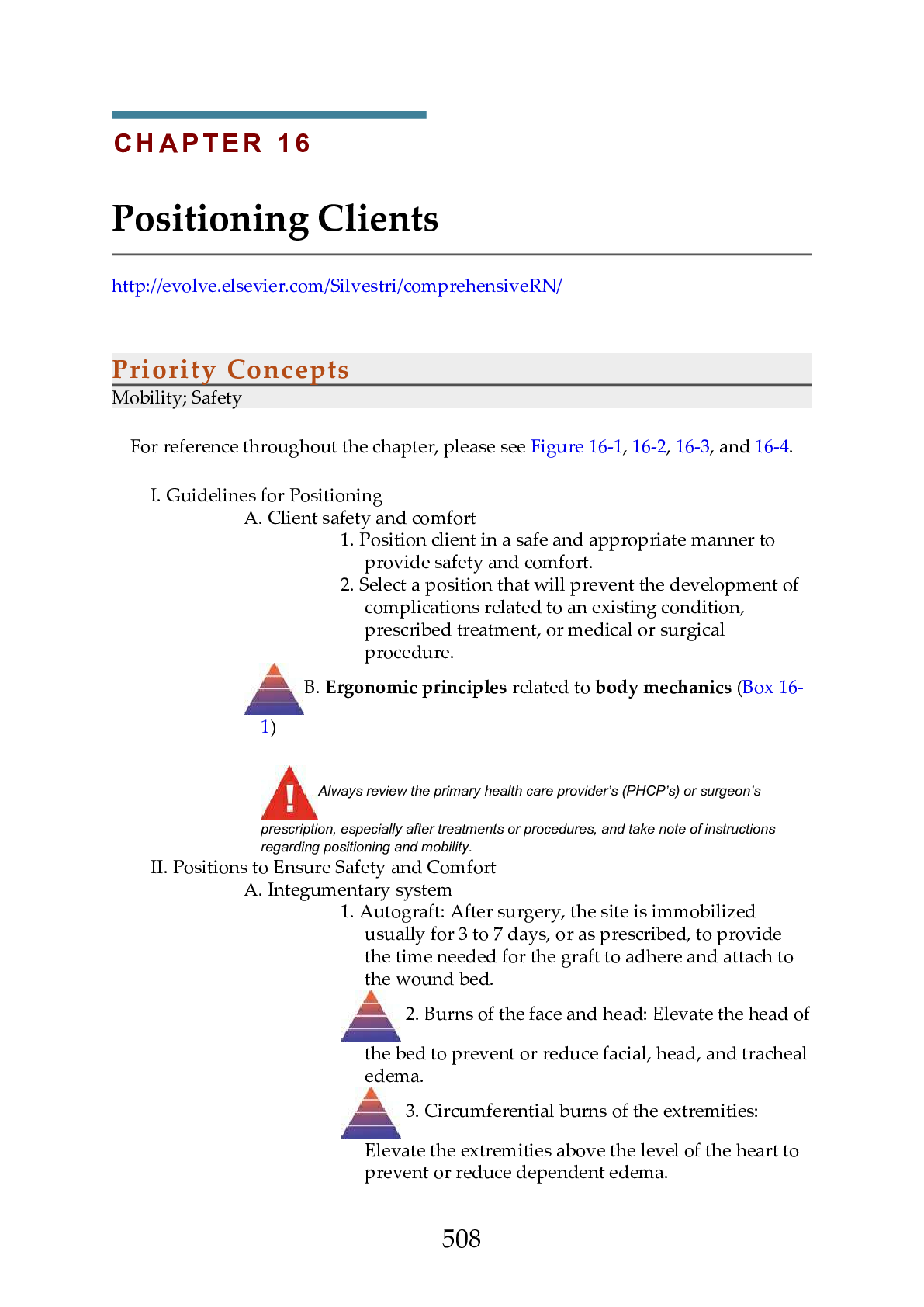


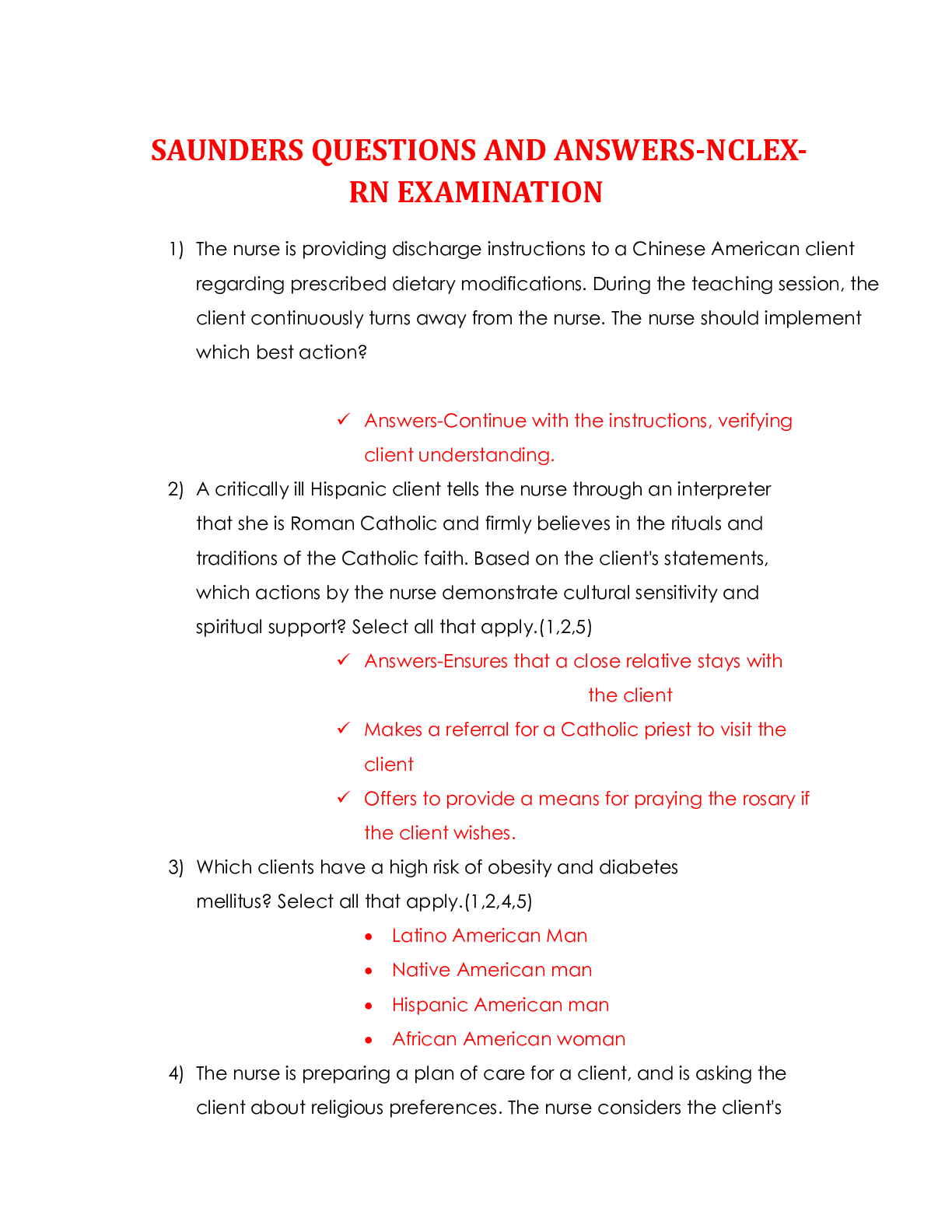

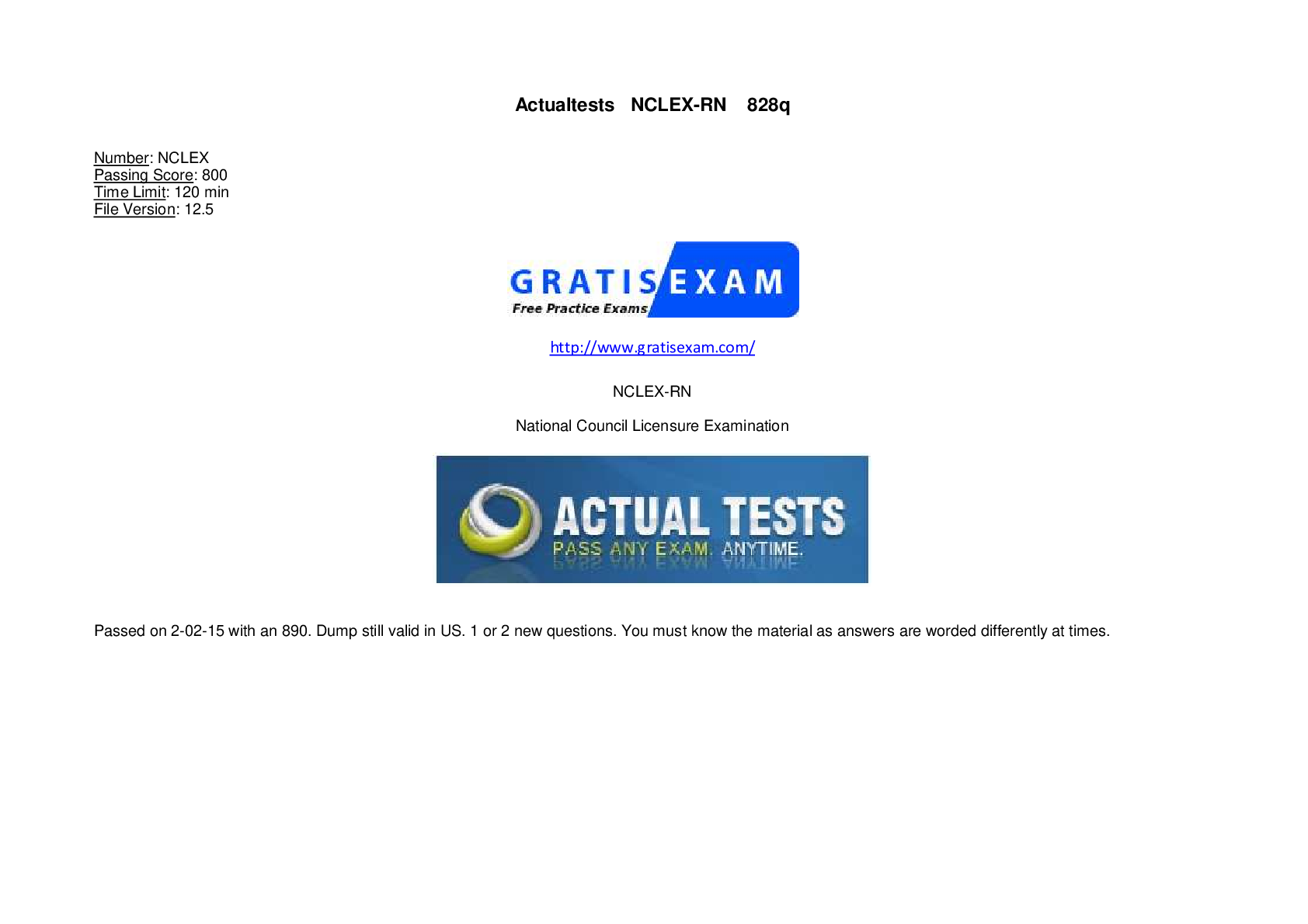
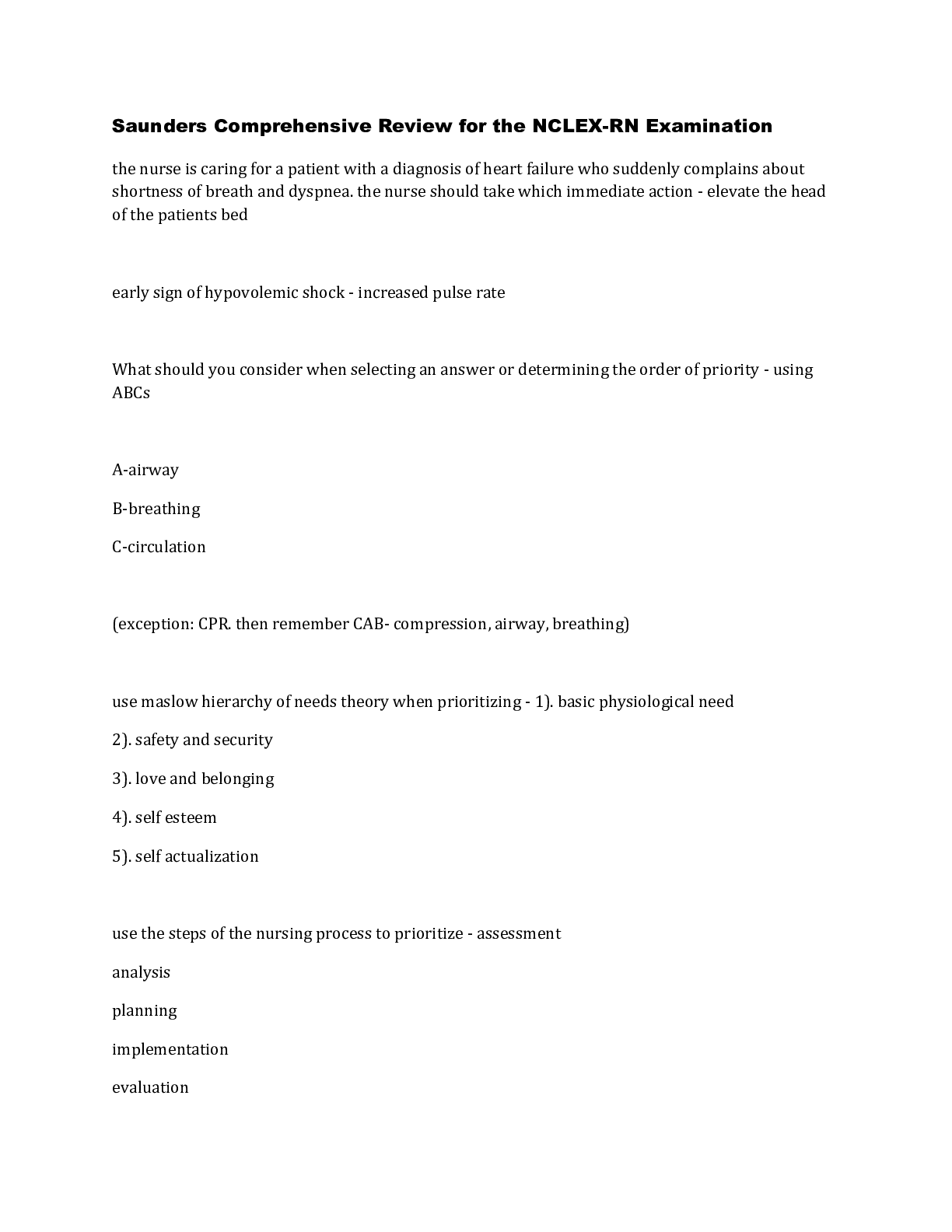


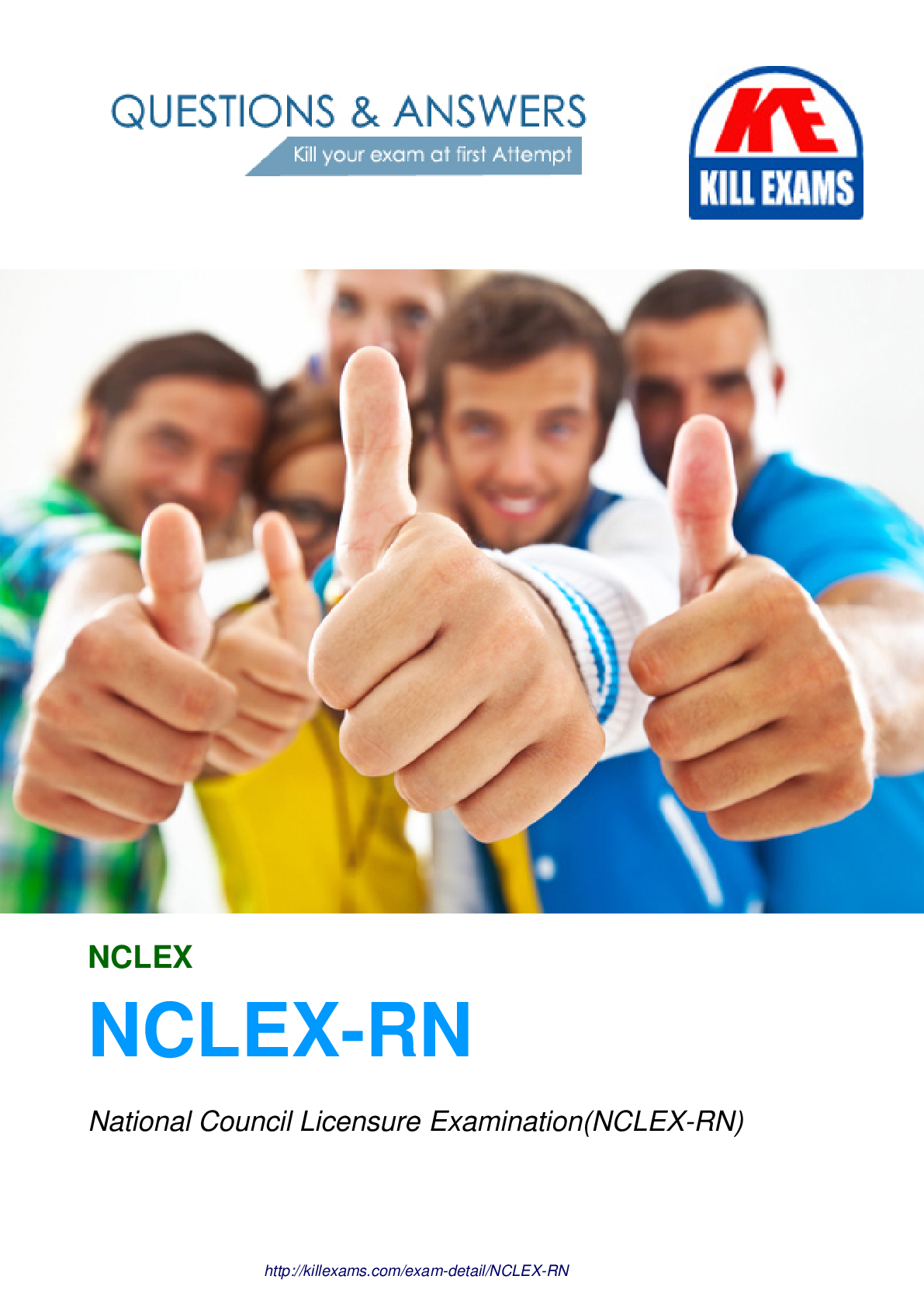


 With 850 Questions And Answers Guaranteed 100% Grade A.png)
